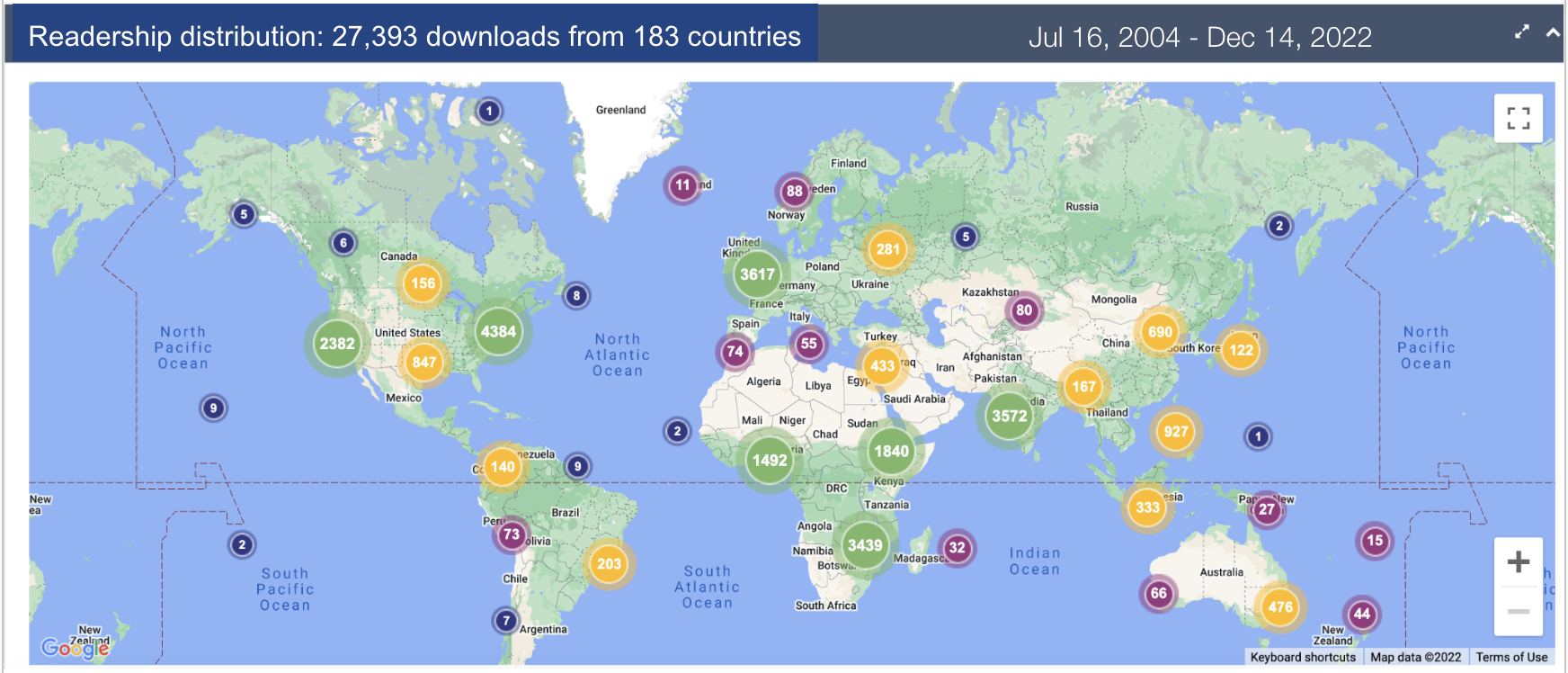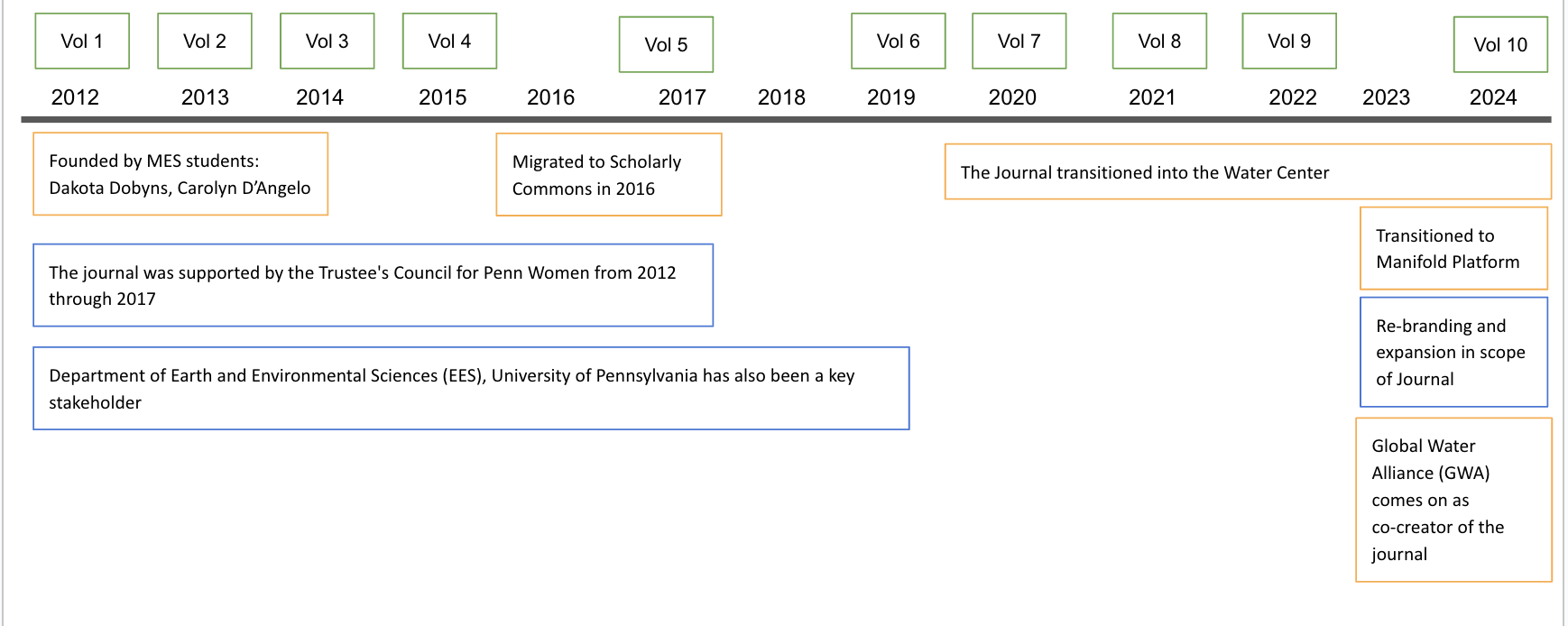Skip to main contentBehind the Scenes: Celebrating a Decade of the International Journal for Water Equity and Justice
by Amisha Shahra
 Figure 3: Readership Distribution map showcasing the reach of the wH2O Journal
Figure 3: Readership Distribution map showcasing the reach of the wH2O Journal
Over the past ten years, the wH2O Journal (Journal of Gender and Water), now known as the International Journal for Water Equity and Justice (IJWEJ), has made significant strides in the field of clean water and sanitation.As we mark the launch of our tenth volume, we take a moment to reflect on our journey and the future of the journal.The wH2O Journal has been under the University of Pennsylvania (Penn) ambit and most recently housed under the Water Center at Penn (see Figure 1 for the detailed timeline). As the journal approached its eleventh year, we recognized that it was imperative to re-evaluate its progress and assess the relevance of the topic in the current global context. For this project, we used a framework centered around design thinking principles. We embarked on a comprehensive research journey to identify key trends and assess comparable journals, ensuring that our vision and strategic roadmap align with the needs of our stakeholders. We conducted interviews, surveys, research, and reviewed case studies, while closely working with stakeholders to get feedback at every stage (Figure 2). Figure 1: Timeline showcasing IJWEJ’s journey thus far
Figure 1: Timeline showcasing IJWEJ’s journey thus far
Figure 2: Overview of process followed for research into the future roadmap of IJWEJ.
Partnerships and Expansion: To bring our vision to life, we invited The Global Water Alliance (GWA) to join as a co-creator for the journal. GWA has been an integral stakeholder since the journal's inception and will add significant value through its diverse and inclusive approach. We also partnered with Penn Libraries, which is transitioning to the Manifold platform, to migrate the journal to a multimodal platform. Moreover, we invited several stakeholders to join as Editorial Board members and as Issue Editors.
Enhancing the Journal's Flexibility and Global Reach:As we prepared for the launch of Volume 10, we introduced several key enhancements to the journal's operations. We adopted a more dynamic model, allowing us to accept articles on a rolling basis. This approach enabled us to foster closer collaboration with authors and optimize our resource utilization. Additionally, our team had the opportunity to participate in the UN Water Week and the UN Sustainable Development Goals Week in 2023. These events provided valuable insights into the pressing global issues and the dedicated professionals working to address them..
IJWEJ Dialog: To respond to the changing needs of the current environment and to take our revised mission forward, IJWEJ Dialog was launched. IJWEJ Dialog is a new introduction to the journal and is the journal's featured blog. This blog provides an exciting avenue for authors and artists to share their work and engage in multimodal publications. It aims to expand the discourse, reach, and impact beyond the traditional scholarly journal format. IJWEJ Dialog aims to bring in a wide range of content, including photo essays, interviews, creative and artistic explorations, experimental engagements, work in languages beyond English, and much more. This diversity of content allows the platform to broaden the scope of the discourse and help to attract a wider audience of readers and authors alike.
We invite you to engage anew with our decade's worth of publications and contribute to the journal's future. We are proud to have reached this milestone and look forward to continuing our mission to promote clean water and sanitation. We hope you will join us on this journey and contribute to the journal's future.
Notes
table of contents
Behind the Scenes: Celebrating a Decade of the International Journal for Water Equity and Justice
by Amisha Shahra
Over the past ten years, the wH2O Journal (Journal of Gender and Water), now known as the International Journal for Water Equity and Justice (IJWEJ), has made significant strides in the field of clean water and sanitation.As we mark the launch of our tenth volume, we take a moment to reflect on our journey and the future of the journal.The wH2O Journal has been under the University of Pennsylvania (Penn) ambit and most recently housed under the Water Center at Penn (see Figure 1 for the detailed timeline). As the journal approached its eleventh year, we recognized that it was imperative to re-evaluate its progress and assess the relevance of the topic in the current global context. For this project, we used a framework centered around design thinking principles. We embarked on a comprehensive research journey to identify key trends and assess comparable journals, ensuring that our vision and strategic roadmap align with the needs of our stakeholders. We conducted interviews, surveys, research, and reviewed case studies, while closely working with stakeholders to get feedback at every stage (Figure 2).
Key Takeaways
Our research revealed three crucial insights:
- Established Presence: The Journal has proven itself to be a great asset! It has carved out a niche, and has gained traction with little effort with a total of 27,393 downloads across 183 countries (with 8,586 in just the last year!) (Figure 3)
- Growing Need: Water resource management and stewardship are increasingly critical issues, exacerbated by global warming, floods, water shortages, and natural and man-made disasters. There is a pressing need to share information, research findings, and solutions.
- Demand for Innovation: There is a growing demand for a more creative platform to host the journal, offering opportunities to engage a broader audience and diverse authors.
The Future Roadmap
Our findings led us to conclude that the future of the journal is bright, and publishing should continue. However, we also recognized the need to identify key strategies for the journal to operate, scale, and achieve its mission for a more resilient and relevant publication. We created a strategic future roadmap to guide our efforts. This roadmap not only outlined a comprehensive rebranding effort of the wH2O but also reflected a broader mission to advance scholarship and work that promotes not only gender equity, but also expands its scope to include issues around equitable access to water resources and environmental justice. IJWEJ’s new vision was to create conditions for innovation, catalyze theoretical and applied research, and serve as a platform for exchange of information to solve critical water problems.Partnerships and Expansion: To bring our vision to life, we invited The Global Water Alliance (GWA) to join as a co-creator for the journal. GWA has been an integral stakeholder since the journal's inception and will add significant value through its diverse and inclusive approach. We also partnered with Penn Libraries, which is transitioning to the Manifold platform, to migrate the journal to a multimodal platform. Moreover, we invited several stakeholders to join as Editorial Board members and as Issue Editors.
Enhancing the Journal's Flexibility and Global Reach:As we prepared for the launch of Volume 10, we introduced several key enhancements to the journal's operations. We adopted a more dynamic model, allowing us to accept articles on a rolling basis. This approach enabled us to foster closer collaboration with authors and optimize our resource utilization. Additionally, our team had the opportunity to participate in the UN Water Week and the UN Sustainable Development Goals Week in 2023. These events provided valuable insights into the pressing global issues and the dedicated professionals working to address them..
IJWEJ Dialog: To respond to the changing needs of the current environment and to take our revised mission forward, IJWEJ Dialog was launched. IJWEJ Dialog is a new introduction to the journal and is the journal's featured blog. This blog provides an exciting avenue for authors and artists to share their work and engage in multimodal publications. It aims to expand the discourse, reach, and impact beyond the traditional scholarly journal format. IJWEJ Dialog aims to bring in a wide range of content, including photo essays, interviews, creative and artistic explorations, experimental engagements, work in languages beyond English, and much more. This diversity of content allows the platform to broaden the scope of the discourse and help to attract a wider audience of readers and authors alike.
Challenges and Opportunities
Throughout our journey, our small team and limited resources have been a constant concern. However, the goodwill and support generated by the journal over the years have been instrumental in helping us navigate these challenges. With the help of our partners and the trust we have built, we have received significant backing. Despite the obstacles we have faced, we are excited about the opportunities ahead. We envision our new platform evolving into a vibrant community that can share and learn from global developments.We invite you to engage anew with our decade's worth of publications and contribute to the journal's future. We are proud to have reached this milestone and look forward to continuing our mission to promote clean water and sanitation. We hope you will join us on this journey and contribute to the journal's future.
Amisha Shahra is the Editor-in-Chief for the International Journal for Water Equity and Justice. She has completed both, her M.A. in Environmental Studies and B.A. in PPE, from the University of Pennsylvania. She currently works as a consultant with the Water Center and the World Bank.
Annotate
Posts